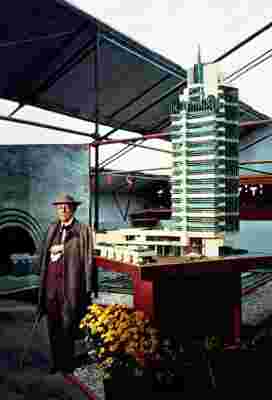The numbers alone are daunting: 55,000 architectural drawings, some 300,000 sheets of correspondence, close to 125,000 photographs, 270 film reels, two dozen models. Those are just the largest categories in the Frank Lloyd Wright archive , amassed over a seven-decade career that yielded more than 500 buildings (some 400 still standing, hundreds of others never realized), not to mention furniture, stained glass, and textiles. With the architect’s 150th birthday upon us—he was born June 8, 1867, though he often fudged the date—a team and I have spent countless hours combing through the trove, which was transferred to the Museum of Modern Art (MoMA) and Columbia University five years ago. The result of our digging debuts on June 12 in the new exhibition “Frank Lloyd Wright at 150: Unpacking the Archive.”

Photographed in New York in 1953, Frank Lloyd Wright stands with his model for Oklahoma's Price Tower, the architects only built skyscraper.
On the eve of the show’s opening, I am reminded of the moment it all began. Six years ago, the Frank Lloyd Wright Foundation called inquiring whether MoMA would be interested in assuming stewardship of all these materials—the logistics of which sent my head spinning. After months of discussion, an agreement was struck between the foundation and a new partnership formed by MoMA and Columbia’s Avery Architectural & Fine Arts Library. Truckloads of documents began to make their way cross-country from Wright’s home/studio compounds at Taliesin in Spring Green , Wisconsin, and Taliesin West in Scottsdale, Arizona, where the archive had been kept; Avery’s storage vaults were recon figured to place Wright front and center; and MoMA’s art conservators rapidly developed plans to restore architectural models. Some, like his severely damaged 1927 proposal for a largely glass residential tower in downtown Manhattan, required major interventions. Others were in excellent shape but still posed mysteries. How was it, for instance, that his first model of the Guggenheim was painted beige and not the stark white of the completed building? The answer—that Wright considered cladding the building in creamy stone—was revealed by conservation forensics and is now captured in one of fourteen short films recording the research of conservators, curators, and scholars. Discoveries can still be made about America’s most famous architect.
Since his death at age 91 in 1959, Wright has commanded more attention than any other architect in history, and he remains a household name. But his archive still contains more surprises than any one person could process. So the idea emerged of inviting 11 other scholars, both seasoned and novice, to sift through the materials for the MoMA exhibition—a kind of intersecting treasure hunt, with each participant coming to terms with a key object (or group of objects) and a key element of Wright’s career.“ Ideas that began as fragments have aligned in unexpected ways, suggesting new patterns, new connections.”
Much like in a kaleidoscope, ideas that began as fragments have aligned in unexpected ways, suggesting new patterns, new connections. Mabel O. Wilson, a Columbia architecture professor specializing in modernism and race, has unpacked a moment in 1928 when Wright was asked to develop a prototype for the Rosenwald Schools program, an initiative launched by Booker T. Washington and Julius Rosenwald (the president of Sears, Roebuck) to build state-of-the-art schools for African-American children in the segregated South. Communities were expected to construct these facilities themselves, a mandate that dovetailed with Wright’s search for building systems that could be easily mastered and constructed affordably. That quest especially captivated one of MoMA’s other guest scholars, former Taliesin apprentice Matthew Skjonsberg, who has studied Wright’s pioneering 1917 assembly system of prefabricated wooden panels, which later gave way to lifelong experiments in do-it-yourself concrete blocks. Landscape historian Therese O’Malley, meanwhile, set out to investigate the hemicycle of plants that extends Wright’s 1905 Martin House, the great Prairie mansion in Buffalo. As she discovered, Wright did not use exclusively native plants, as we have so often been told. What’s more, the client, Darwin D. Martin, turned out to be the very same person who, years later, would introduce the architect to Rosenwald.


Arranged in an open plan to maximize connections among objects, the exhibition is filled with unearthed treasures, from a little-known photo album showing rare views of Wright’s Imperial Hotel in Tokyo to plans for an entire suburb consisting of circular house plots. As the starting point for my own research, I reserved Wright’s nearly nine-foot-tall drawing for the Mile High Illinois tower, an experimental project he unveiled at a Chicago press conference in October 1956. This publicity stunt—it made headlines for weeks—led me to watch that same year’s episode of the popular game show What’s My Line? in which Wright appeared as the mystery guest. A blindfolded panelist asked if he painted, and when Wright didn’t deny that he did, another wondered aloud whether he worked in an allied eld “such as design or architecture, such as Frank Lloyd Wright.” His identity inadvertently unmasked, the architect proceeded to tell the audience about his latest achievement, a tall building “on the western Prairie” for the Price Company in Bartlesville, Oklahoma. Even in his late 80s, the architect had mastered the new medium of broadcast. The world’s first starchitect had arrived.

Leave a Reply